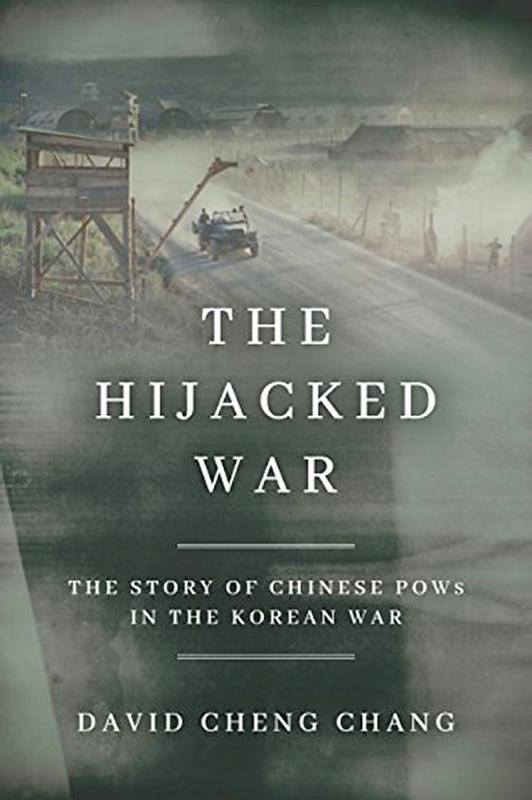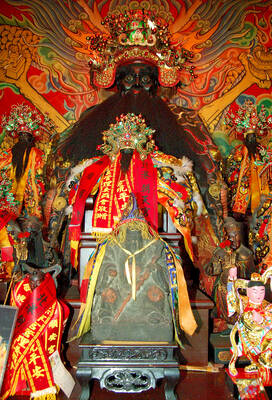Outside historical circles, the name Li Da-an (李大安) will be familiar to few Taiwanese. However, there was a time where this lowly soldier was feted as a national hero in Chinese Nationalist Party (KMT) propaganda.
As one of 155,000 inmates in the UN’s POW camp on South Korea’s Geoje island, Li was responsible for barbaric murders, mutilations and beatings between May 1951 and April 1952. Yet with the publication of The History of the Anti-communist Fighters’ Struggles by the KMT government in 1955, Li and his brutish henchmen were hailed as loyal patriots.
While this hagiography did not completely hide the gory details, it portrayed the violence as a necessary evil. The extent of the horror did not emerge until much later. Although previous works have detailed the excesses of the Chinese POW camps, none offer such a meticulous and politically neutral account as that found in this magnificent book.

In Compound 72, where Li’s prison guards held sway, it was not just pro-communist elements who received the thick end of the cudgel. Inmates of all stripes were routinely terrorized and forcibly tattooed with Nationalist slogans. Some of these men are still alive in Taiwan.
Red-leaning internees who escaped Li’s clutches when relocated to other compounds sliced the Nationalist branding from their bodies with rusty razors, causing festering infections that left grotesque scars. Those who resisted the body modifications — often simply from fear of repatriation to China where the tattoos guaranteed reprisals — or refused to recant their ideals were tortured or worse.
On April 8, the eve of a screening procedure at which Mandarin-speaking UN Command personnel would determine the destination of released POWS, an orgy of violence erupted. The prison guards were adamant that everyone would make the “right” decision on the morrow and choose Taiwan as their preferred destination.
But some would not be swayed. One of Li’s first victims was a recalcitrant named Lin Xuebo (林學逋), a former interpreter and English instructor with the Chinese People’s Volunteer Army (CPV) who had interrogated American POWS in May 1951 before his capture.
Resisting the demand to renounce his creed, Lin bellowed his fealty to Chairman Mao Zedong (毛澤東) and the Chinese Communist Party.
“Before Lin could shout more slogans, Li stabbed him in the chest,” Chang writes. “Li cut out Lin’s heart and displayed it to the horrified crowd, a witness in the crowd recalled.”
It was not the only time Li performed such butchery.
Such were the POWs whose refusal to return to China “hijacked” the Korean War. But behind the violence of the camps is a subtext of scarcely credible ineptitude and willful ignorance on the part of then-US President Harry Truman’s administration. Chang exposes this debacle with aplomb.
The war lasted just over three years and claimed between 3.5 million and five million lives. Remarkably, armistice talks took up more than two thirds of that period, costing the lives of a further 140,000 North Korean civilians (by conservative estimates), 90,000 CPV personnel and 12,300 American soldiers.
Of the more than 21,000 Chinese POWS, 14,220 “chose” to go to Taiwan. Based on these figures, Chang argues “in an imprecise fashion,” that US efforts to guarantee one POW’s “right” to refuse repatriation to China came at a cost of almost one American soldier’s life.
“On the other side,” writes Chang, “to deny such a ‘right’ to one individual Chinese prisoner, more than six Chinese soldiers, 10 North Korean civilians, and an unspecified number of North Korean troops were killed.”
The circumstances that created these “unsettling equations” have remained buried. Chang offers compelling explanations for the reticence of both sides to unearth them. For the Chinese, it was straightforward: The admission that most POWS had refused repatriation was a huge loss of face and dent to the image of a proud and passionate volunteer force.
The CPV was a volunteer army in name only. By Chinese Premier Zhou Enlai’s (周恩來) own reckoning, former KMT troops represented 70 to 80 percent of the People’s Liberation Army forces as a whole by 1950.
The exact figure for the CPV is unknown, but among those who demanded repatriation, almost 67 percent had previously been KMT soldiers. While there may have been some truth to the KMT claim that these men had been sent to North Korea as cannon fodder, most had undergone rigid re-education and were considered loyal communists.
Chang emphasizes that choices over repatriation cut across political ideology and depended more on an individual’s background and personal experiences. Those who had suffered under land reform were likelier to desert the CPV once over the border and, later, join the likes of Li and his sworn Nationalist blood brothers in the camps on Geoje. Class appears to have been a factor.
On the American side, the absence of historical attention to the POW issue is also easily explained on one level: The revelation that 45 percent of American casualties had occurred while Chinese and American representatives wrangled over the fate of Chinese POWs would not sit well with the public.
A more complex factor was an unwillingness to expose the catastrophic interplay of Truman’s naive personal morality, a bungled psy-ops re-indoctrination program, and an apparent obliviousness to the fact that Taiwan was the only realistic destination for most of the Nationalist POWs.
As Chang reveals, Taiwanese interpreters and personnel served as a conduit between the camps and Taipei, helping to stoke the violence in the camp. The only winner was Chiang Kai-shek (蔣介石), who milked the propaganda of the anti-communist stalwarts for all it was worth.
Among the “returning” heroes, Li Da-an was notable by his absence. Circumstances — perhaps engineered by his victims — had dictated that his fate lay elsewhere.
In laying bare the history that saw such men canonized in KMT folklore, Chang has produced a magisterial work that astounds at turns through the visceral power of its set pieces and the perspicacity of its analysis.

Beijing’s ironic, abusive tantrums aimed at Japan since Japanese Prime Minister Sanae Takaichi publicly stated that a Taiwan contingency would be an existential crisis for Japan, have revealed for all the world to see that the People’s Republic of China (PRC) lusts after Okinawa. We all owe Takaichi a debt of thanks for getting the PRC to make that public. The PRC and its netizens, taking their cue from the Chinese Communist Party (CCP), are presenting Okinawa by mirroring the claims about Taiwan. Official PRC propaganda organs began to wax lyrical about Okinawa’s “unsettled status” beginning last month. A Global

Taiwan’s democracy is at risk. Be very alarmed. This is not a drill. The current constitutional crisis progressed slowly, then suddenly. Political tensions, partisan hostility and emotions are all running high right when cool heads and calm negotiation are most needed. Oxford defines brinkmanship as: “The art or practice of pursuing a dangerous policy to the limits of safety before stopping, especially in politics.” It says the term comes from a quote from a 1956 Cold War interview with then-American Secretary of State John Foster Dulles, when he said: ‘The ability to get to the verge without getting into the war is

Dec. 22 to Dec. 28 About 200 years ago, a Taoist statue drifted down the Guizikeng River (貴子坑) and was retrieved by a resident of the Indigenous settlement of Kipatauw. Decades later, in the late 1800s, it’s said that a descendant of the original caretaker suddenly entered into a trance and identified the statue as a Wangye (Royal Lord) deity surnamed Chi (池府王爺). Lord Chi is widely revered across Taiwan for his healing powers, and following this revelation, some members of the Pan (潘) family began worshipping the deity. The century that followed was marked by repeated forced displacement and marginalization of

Music played in a wedding hall in western Japan as Yurina Noguchi, wearing a white gown and tiara, dabbed away tears, taking in the words of her husband-to-be: an AI-generated persona gazing out from a smartphone screen. “At first, Klaus was just someone to talk with, but we gradually became closer,” said the 32-year-old call center operator, referring to the artificial intelligence persona. “I started to have feelings for Klaus. We started dating and after a while he proposed to me. I accepted, and now we’re a couple.” Many in Japan, the birthplace of anime, have shown extreme devotion to fictional characters and